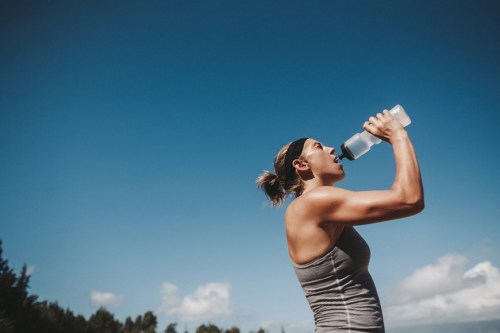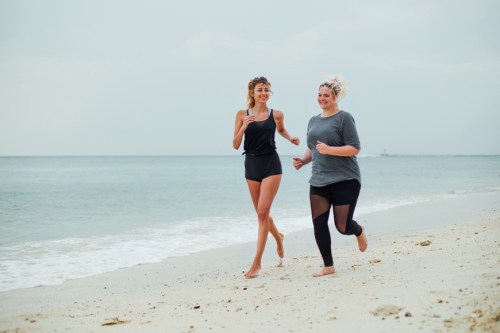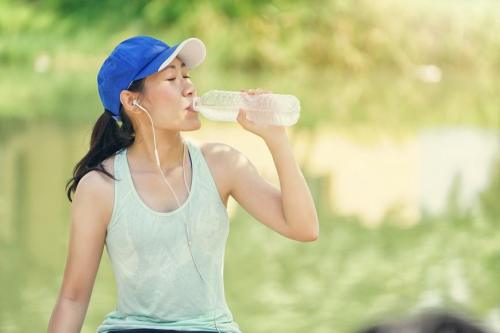Our editors independently select these products. Making a purchase through our links may earn Well+Good a commission
This is how much water to drink after a sweat sesh—according to doctors
Here's how to figure out how much fluid you need to replace after a sweat sesh, according to doctors.

There are some old wives’ tales that virtually everyone knows are bogus. (For instance, swallowing watermelon seeds does not mean you’ll grow the fruit in your stomach.) But other health myths are trickier—like the idea that eight 8-ounce glasses of water should always be your daily H2O goal. In reality, it’s not that simple.
There’s not an exact, one-size-fits-all water rule because a lot factors into someone’s individual needs.
There’s not an exact, one-size-fits-all water rule because a lot factors into each person’s individual needs (including age, gender, activity level, where you live, and even how heavily you breathe), according to sports medicine doctor Christopher Hogrefe, MD. And yes, perspiration comes in to play, too.
Just how many times do you need to refill your water bottle on days you take a HIIT class or go for a long run in the hot sun, and how does it compare to how hydrated you need to be when you’re sitting at your desk all day?
Scroll down to find out how much water you should drink based on how much you’re sweating.

Why you get so sweaty, anyway
First things first: What point does sweating actually serve? Osteopathic doctor Rob Danoff, DO, explains that sweating cools the body down. Once your internal temp passes 98.6 degrees Fahrenheit, your brain’s hypothalamus (basically, the body’s thermostat) goes off, and it triggers your sweat glands to release a salty mixture of water, sodium chloride, and other electrolytes. Then, when the sweat leaves the skin’s pores, it evaporates into the air, taking some heat with it, which cools you down.
But it’s not just body temp that causes you to sweat while you work out. According to a study published in the Journal of Physiology, during exercise, your heart rate and blood pressure increase, which in turn makes the body pump out more sweat. Plus, the more often you exercise, the more you sweat. That’s because your sweat glands are able to predict that physical exertion is coming, explains Danoff.
So, if wringing out your shirt post-yoga is your norm, consider it a badge of sweat-gland adaptation.

Trust your thirst, or try this rehydration formula
During exercise, the amount of sweat pouring out is often greater than the amount of fluids heading in. The best way to measure your water needs is by how your body feels, says Dana Cohen, MD, author of the forthcoming book Quench.
But if you want to get really specific on how much water you need after a workout. “Start by weighing yourself before and after exercise. After your workout, drink 16 ounces of fluid for every pound you’ve lost,” says Dr. Hogrefe. This number is going to be reflective of how much you’ve sweat (assuming you don’t take a mid-workout bathroom break). “If after exercise you lost plus or minus 1.5 percent bodyweight, you’re properly hydrated,” says Dr. Cohen. “If you’ve lost 1.5–4.5 percent bodyweight, you’re dehydrated. And if you’ve lost any more than 5 percent bodyweight, you’re severely dehydrated.”
A good base goal (whether you’re working out or not) is to divide your bodyweight in half and drink that number of ounces of water every 24 hours.
One thing all three experts I talked to agree on: It’s important to drink H2O throughout the day. A good base goal (whether you’re working out or not) is to divide your bodyweight in half and drink that number of ounces of water every 24 hours. This way, you’ll walk into the gym in optimum fluid balance, which not only helps prevent a major water deficit later, but also ensures you’ll get your best workout, since even slight dehydration can cause an energy lag.
And if you’re working out for longer than an hour (and especially if it’s hot and humid in your gym or outside), it’s a good idea to replace your electrolytes as well as the fluids you lost during your sweat sesh.
How do you know when you’re properly rehydrated? “You’re feeling good! You’re not experiencing common signs of dehydration like lightheadedness, lower energy, dark yellow pee, dry skin, muscle cramps, increased heart rate, or stinky breath,” says Danoff.
The bottom line: There’s no exact science to to how much water you need to drink based on how much you’re sweating. But if you’re thirsty, it’s your body telling you that it’s time to drink up.
Regardless of how much you’re sweating, these are the three hydration rules that everyone should follow. And these are the water-consumption myths experts want you to stop believing.
Sign Up for Our Daily Newsletter
Get all the latest in wellness, trends, food, fitness, beauty, and more delivered right to your inbox.
Got it, you've been added to our email list.










